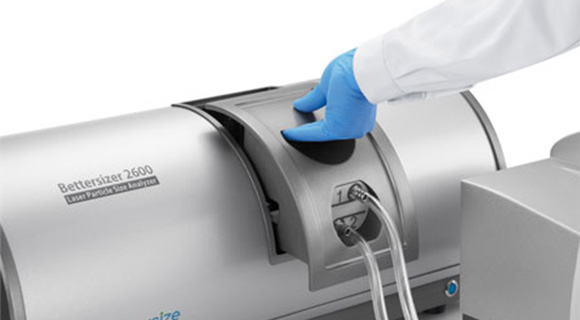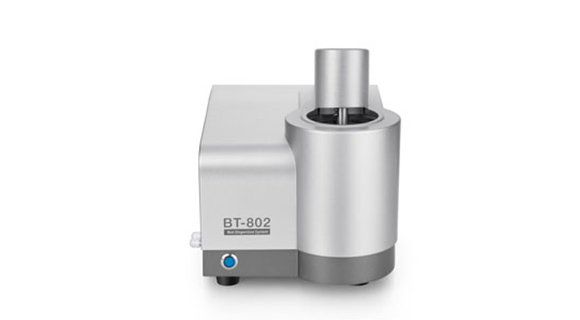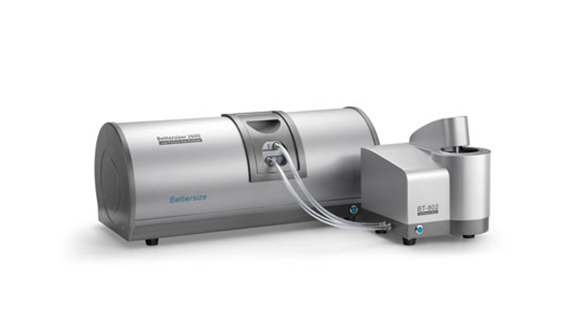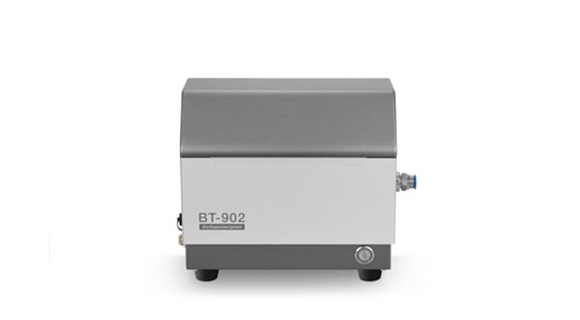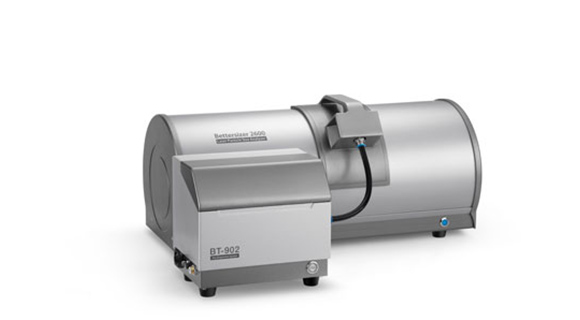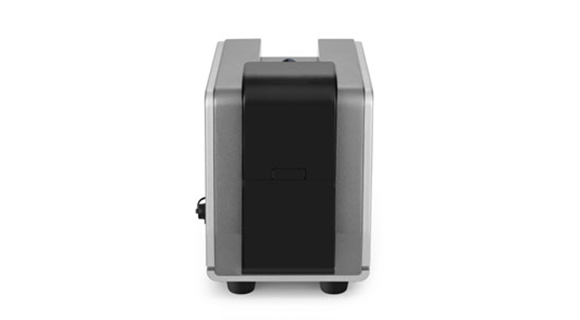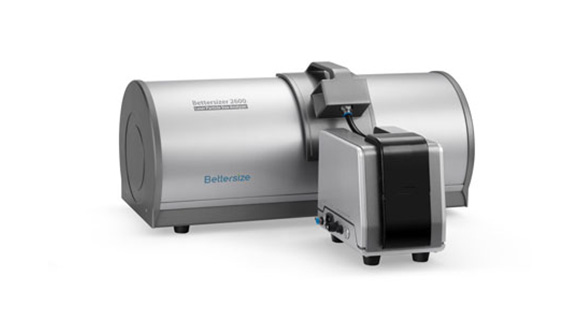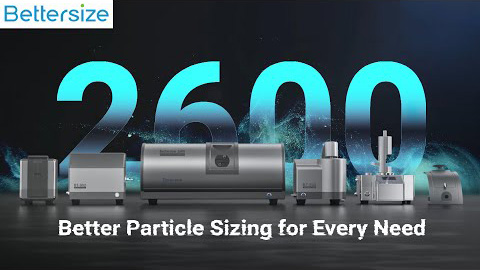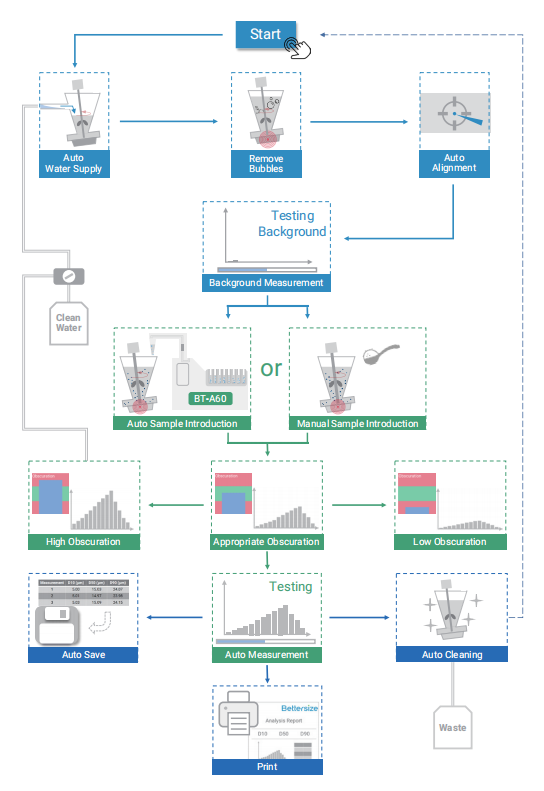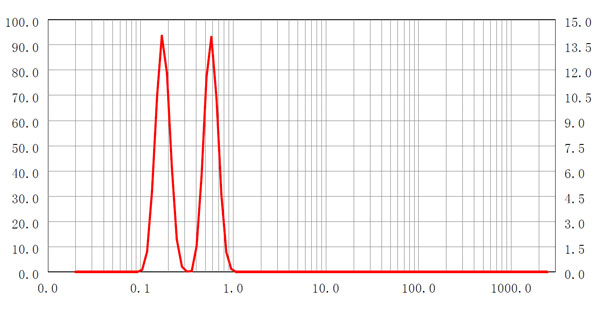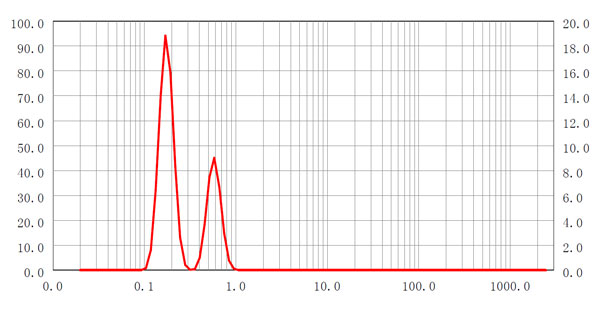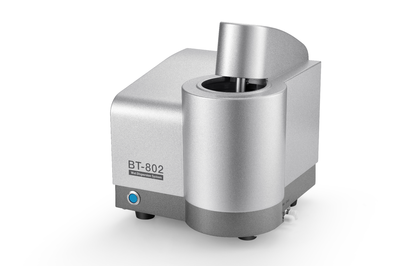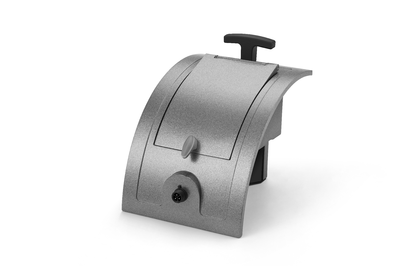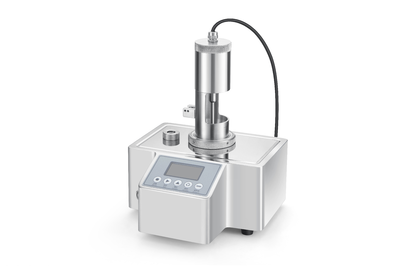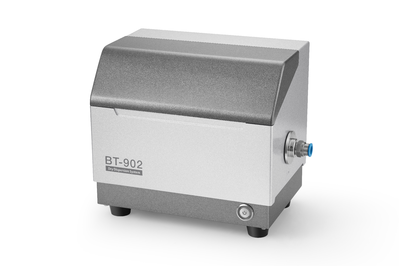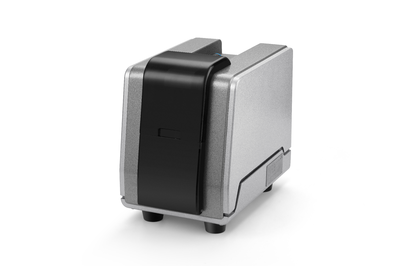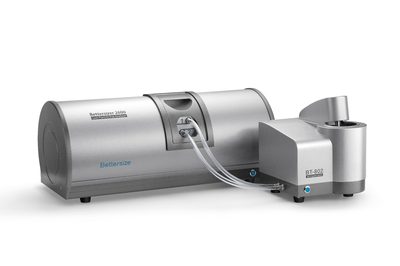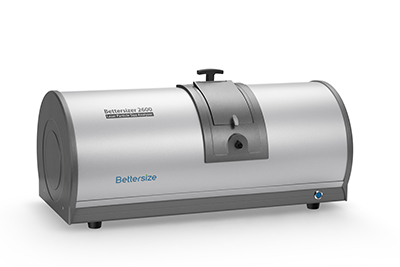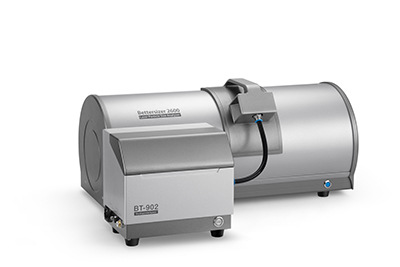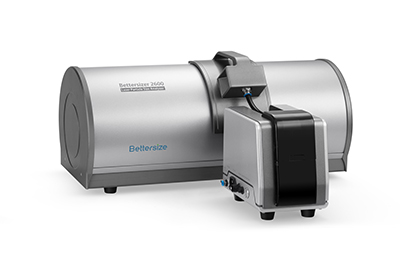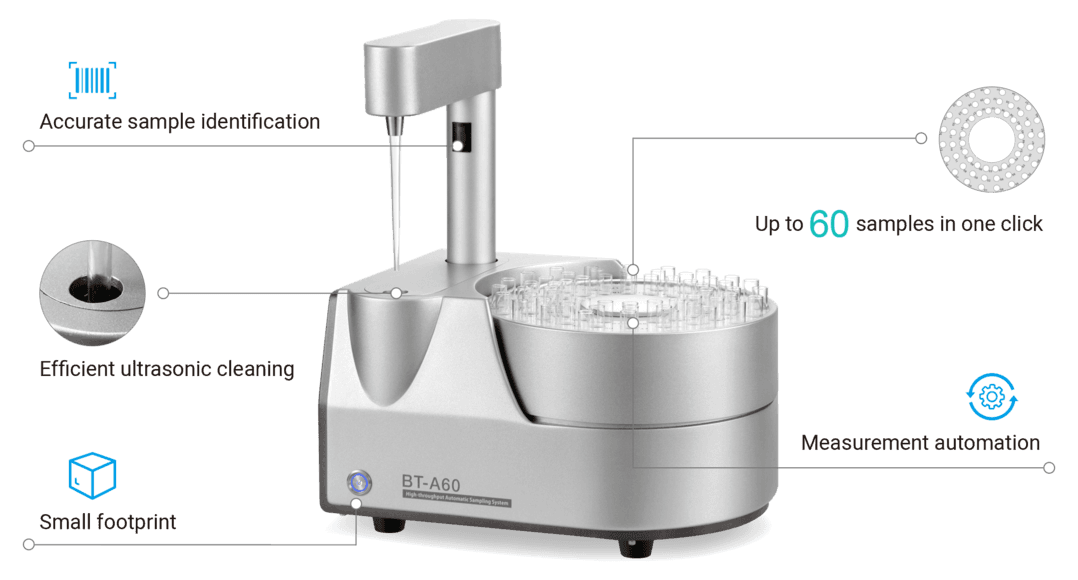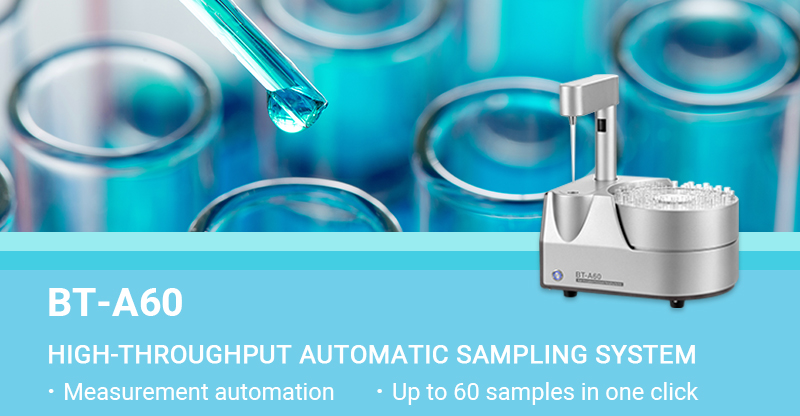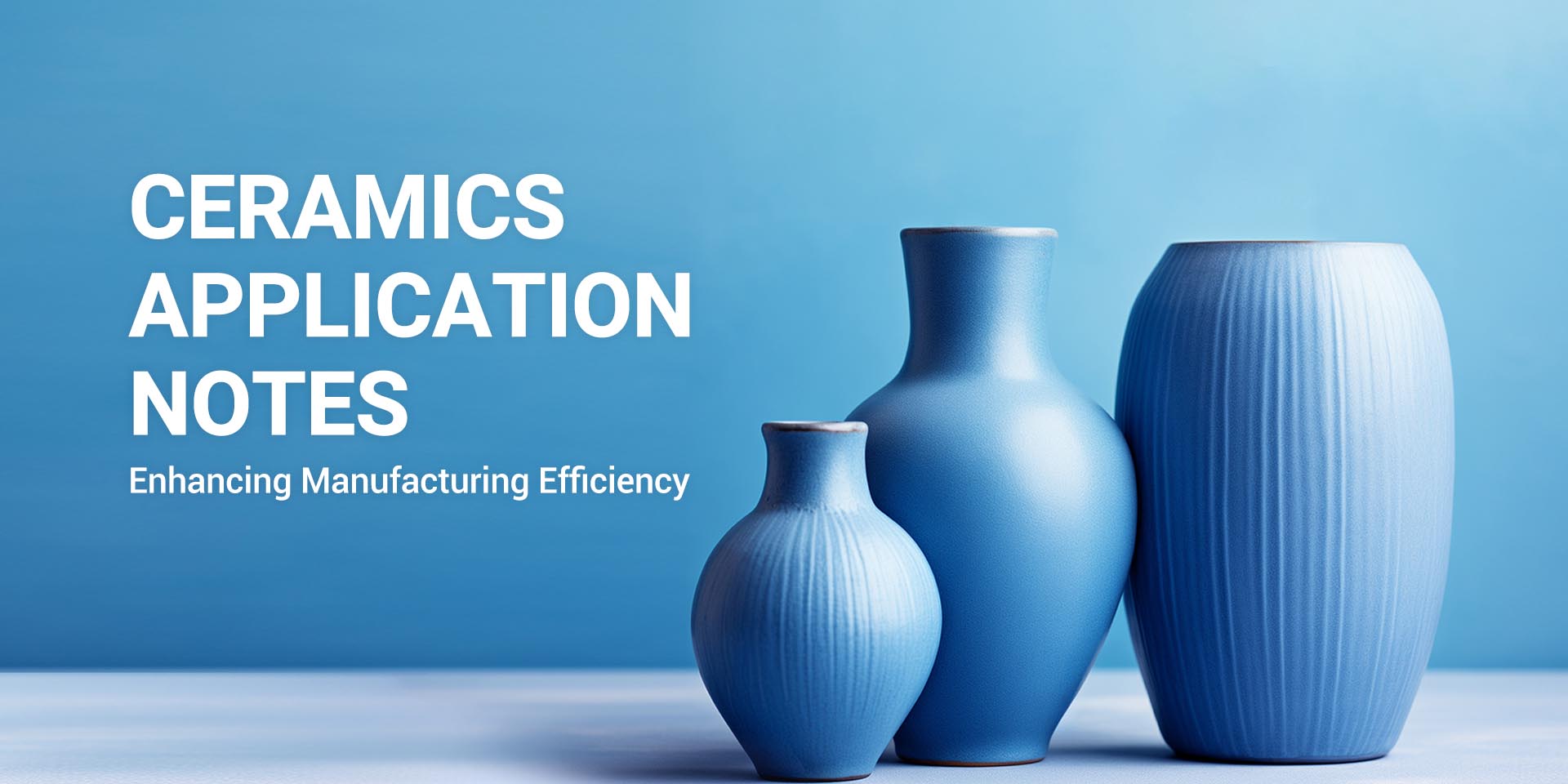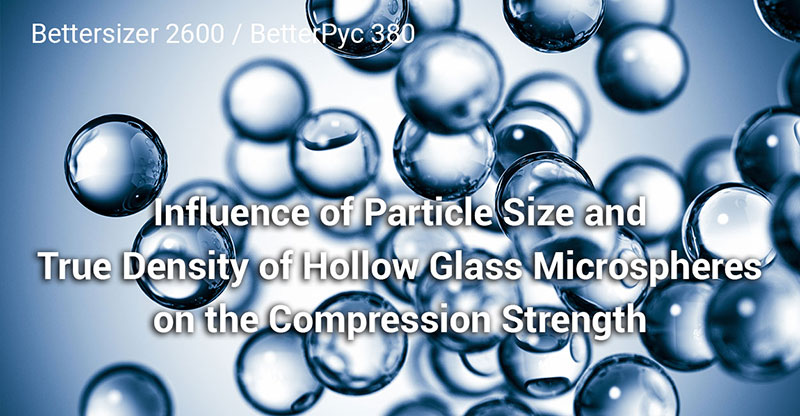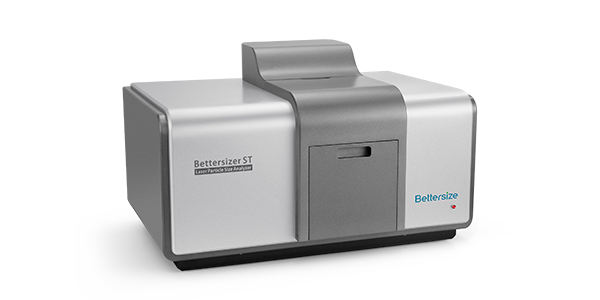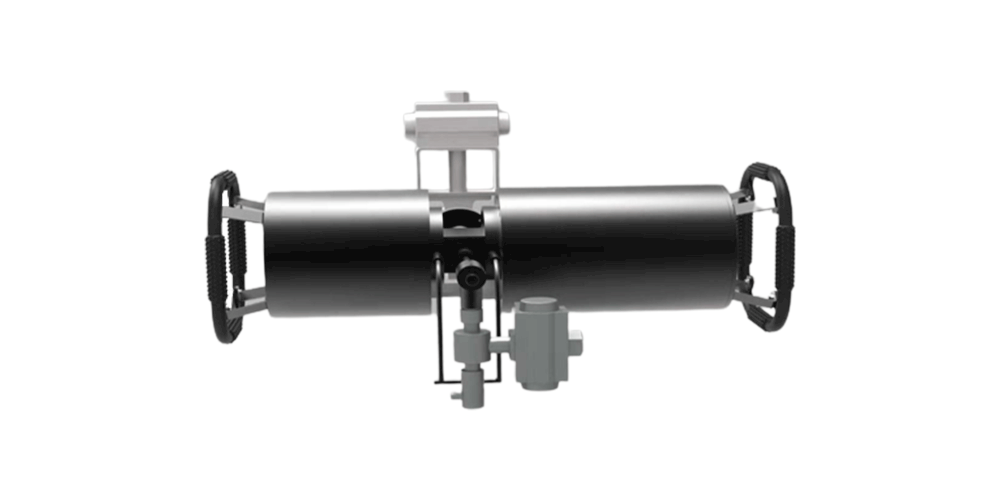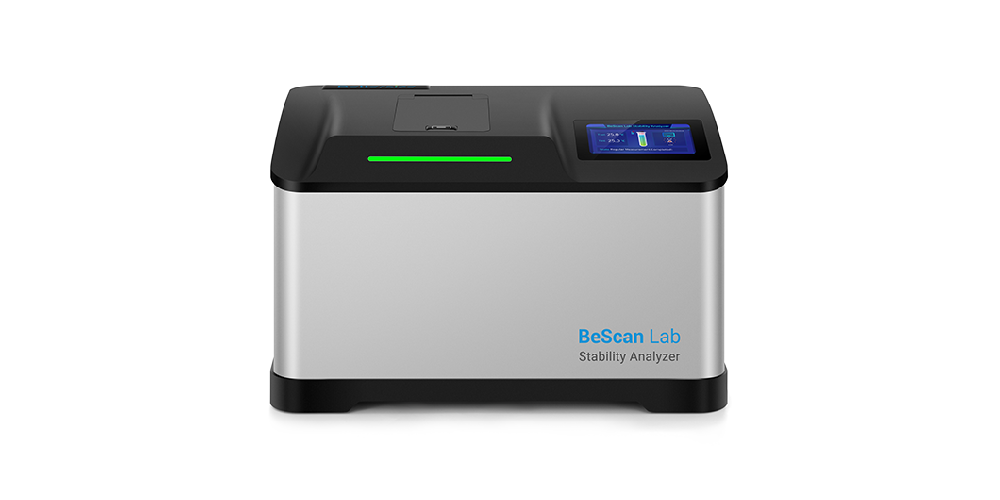Bettersizer 2600
Particle size can be measured by either wet or dry method, using the Bettersizer 2600. A variety of applications have been covered by this versatile, powerful analyzer with its modular design and patented technologies. Users can characterize materials from 0.02 μm to 2600 μm, easily and accurately.
Features and Benefits
- ● Technology: Laser diffraction
- ● Particle size range: Wet dispersion: 0.02 to 2,600μm Dry dispersion: 0.1 to 2,600μm
- ● Wet and dry method of particle sizing is suitable for a wide variety of dispersing particle systems
- ● Precise measurement of both large and small particles covering the broadest range by a new patented technology utilizing both Fourier and Inversed Fourier optical systems
- ● Optical bench with 92 detectors covering an angular range of 0.016° - 165° Optional wet and/or dry dispersion
- ● Small volume dry dispersing module for small sample quantities especially for pharmaceutical or valuable samples in short supply
- ● Easy and fast to changeover between dispersing modules
- ● Easy to implement, create and use Standard Operation Procedures for new materials
- ● Refractive index measurement for providing a more accurate parameter to calculate the results.
- ● User-friendly software, easily learnt
Video
How to Install and Operate Bettersizer 2600 
Bettersizer 2600 | Laser Diffraction Particle Size Analyzer (Wet & Dry) 
Snippet - How to Measure Particle Size of Coffee Powder 
Ask an Expert! Introducing Bettersizer 2600 
A Brief Introduction to Laser Diffraction | Fundamentals of Bettersizer 2600 
Bettersizer 2600 Demonstration with Corundum (Al2O3) sample 
How to Measure Particle Size of Cosmetics 
How to Measure Particle Size of Coffee Powder 
Bettersizer 2600 Overview | Laser Diffraction Particle Size Analyzer (Dry & Wet Dispersions) 
Overview
1. Fourier and Inverse Fourier Optical System
The Bettersizer 2600 is superior in the combination of Fourier and inverse Fourier designs. This smart design allows, on the one hand, the detection of scattered light in a very wide angular range from 0.016° to 165°. On the other hand, in contrast to the inverse Fourier design, the particles do not have to lie on one plane – the simultaneously accurate measurement of small and large particles is therefore achieved.
Features of the combination of Fourier and inverse Fourier design
- Spherical detector array: Forward, lateral and backward detectors in 92 pieces in total;
- Super large Fourier lens;
- Small footprint: Compact design to save space.
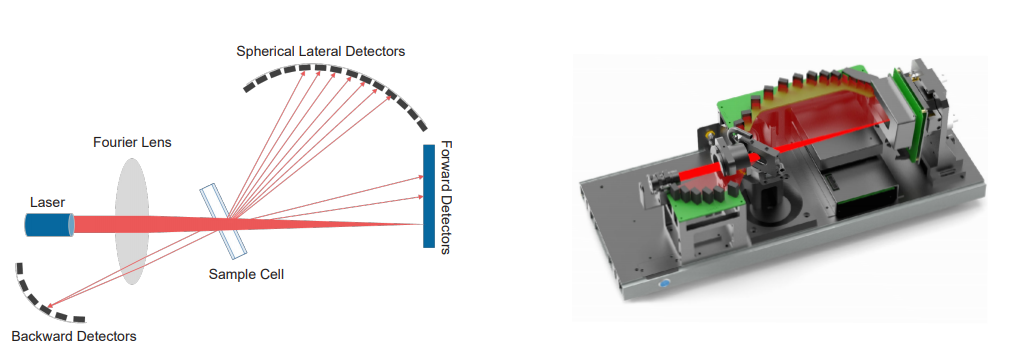
2. Intuitive and Powerful Software
- Intuitive user interface and orderly operation
- Real-time PSD curve for determining the optimal measurement conditions
- Fully automatic measurement routine
- Automatic cleaning routine
- Automatic data backup and highly customizable reports
- Direct conversion according to Fraunhofer and Mie evaluation models
- Switch between wet and dry dispersion modules with one click
3. Wet Dispersion
BT-802 is designed for particle size measurement with water as the medium.
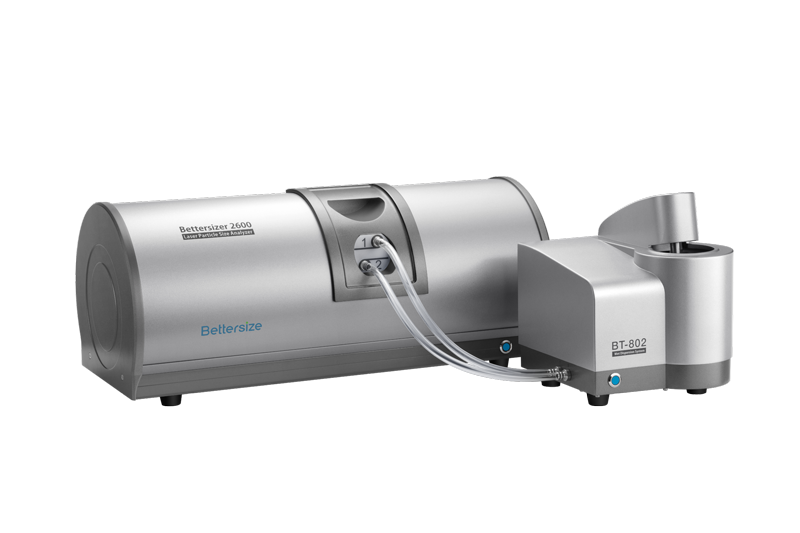
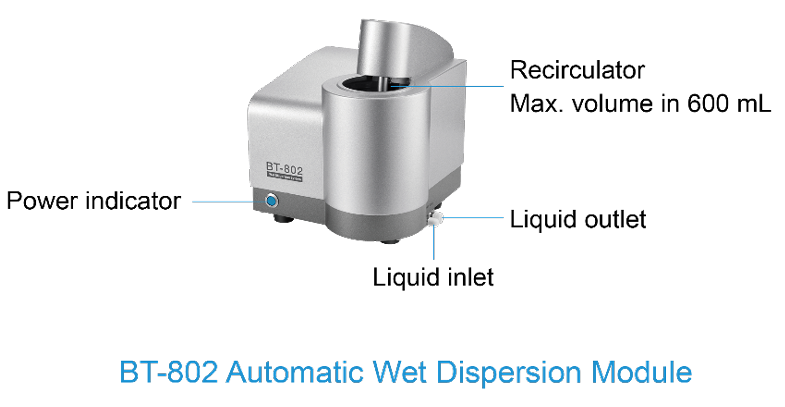
| Ethanol | Methanol | Isopropanol | Ether |
| Toluene | Xylene | Dichloromethane | Octane |
| Ethyl acetate | Acetone | Methyl oleate | NMP solvents |
BT-80N is made up of stainless steel shell. The components of it include a centrifugal pump, an ultrasonic disperser, a PTFE pipeline, a sintered-quartz sample cell, a control circuit, etc.
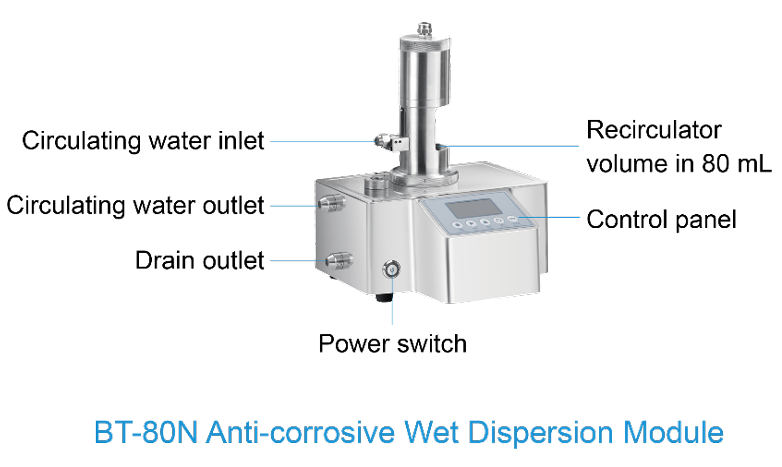
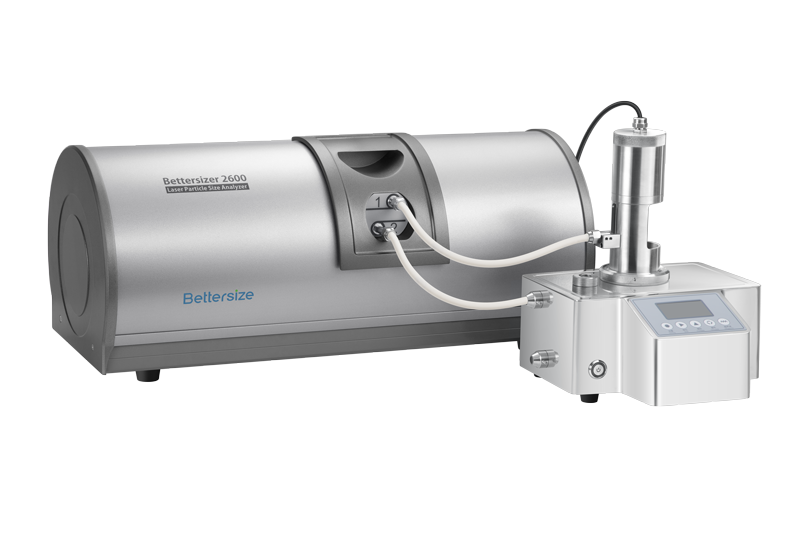

BT-804 is designed for valuable or small-volume sample measurements, where the medium is solvent or water. The module consists of an ABS shell, a stirring motor, a cuvette (8 ml), a stirrer, etc.
- Maximum volume in 8 mL with samples mass in 0.005 - 0.1 g.
- Suitable for samples dispersed in water or organic phase.
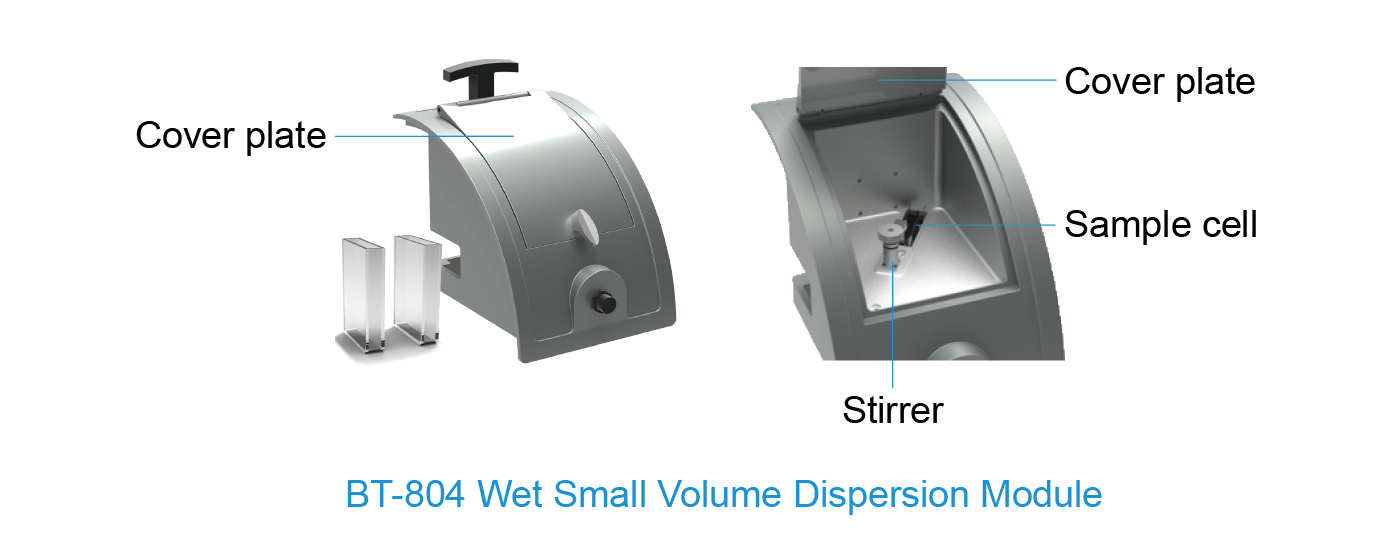
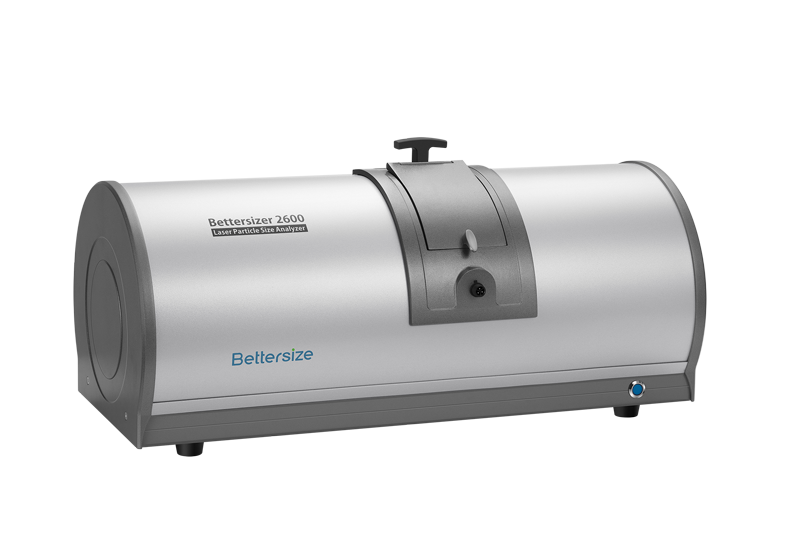
4. Dry Dispersion
BT-902 is suitable for dry powder measurements. The gas used can be compressed air, nitrogen or other noble gases.
BT-902 is made up of an electromagnetic vibration feeder, a venturi pipe, a gas circuit, an electric circuit, a pressure sensor, etc.
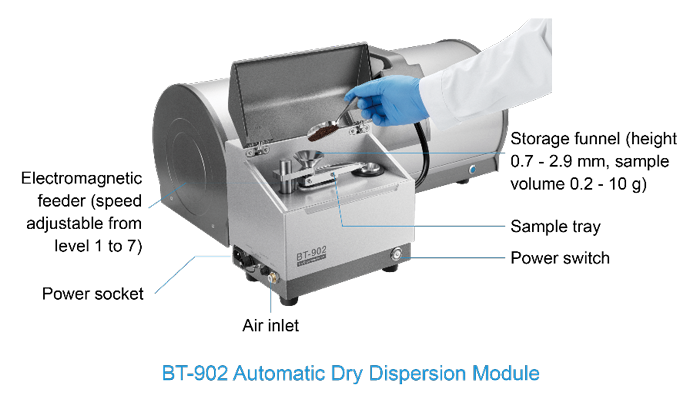

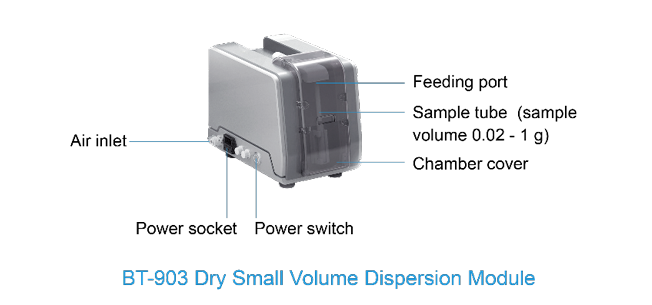
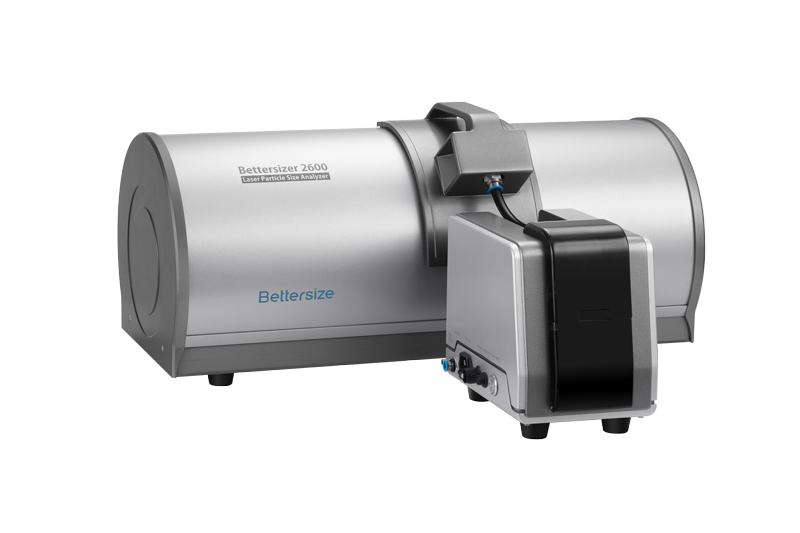
5. Applications
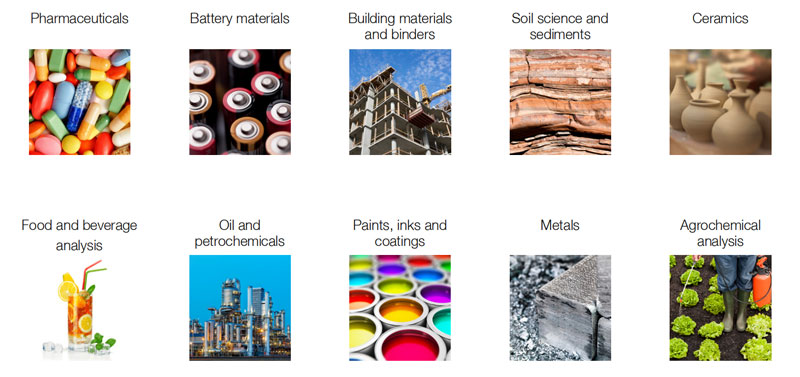
Citations
- Bettersizer 2600
Functional redundancy as an indicator for evaluating functional diversity of macrobenthos under the mussel raft farm near Gouqi Island
DOI: 10.1016/j.aquaculture.2023.740024 Read ArticleZhejiang Ocean University | 2024Biological traits analysis (BTA) helps to evaluate the effects of different environmental variables on the traits-based functional composition of macrobenthos. However, research on functional traits of macrobenthos under mussel farming is limited. We investigated the spatial and temporal response of the benthic system in terms of taxonomic and functional diversity to environmental variables of farming and natural stressors resulting from suspended mussel farming near Gouqi Island of eastern China Sea. The functional traits of macrobenthic assemblages under mussel farming were characterized by “medium adult body size”, “vermiform body form”, “high flexibility”, “infauna”, “semi-motile”, “gonochoristic”, “surface deposit-feeders”, “carnivores”, “semi-motile burrowers”, and “tube-dwellers”. Functional redundancy was stable in response to mussel farming stresses among seasons, whereas species diversity showed efficient to evaluate natural variables. Functional diversity was significantly affected by farming stressors rather than natural variables, Further analysis using multivariate methods together with continuous monitoring were highlighted to evaluate the impacts of mussel farming. Our results reinforce the importance of macrobenthic species and functional traits analysis to evaluate human stresses driven impacts in offshore ecosystems. By analysing the environmental variables with different sources, independently, we concluded the main effects of human pressures on macrobenthic community. Such distinction could be particularly effective to isolate variable environmental descriptors and evaluate their effects on functional diversity, making the current approach promising for the evaluation of ecological effects of anthropogenic stressors in aquaculture areas. - Bettersizer 2600
Degradation characteristics and utilization strategies of a covalent bonded resin-based solid amine during capturing CO2 from flue gas
DOI: 10.1016/j.seppur.2023.125621 Read ArticleChina University of Petroleum | 2024In this study, various types of degradation as well as attrition which are possibly encountered in a circulating fluidized bed temperature swing adsorption (CFB-TSA) process, were conducted experimentally to evaluate the stability of a resin-based solid amine sorbent. Other characterizations methods, such as elemental analysis (EA), Fourier transform infrared spectroscopy (FTIR) etc. were applied to further reveal the degradation mechanisms. The results showed that thermal degradation occurs from 140–160 °C due to the decomposition of amine group. The CO2-induced degradation occurs from a higher temperature of 160–180 °C accompanied by the production of urea. Hydrothermal stability is good below 130 °C, but the ionic impurities in steam crystalized on particle surface can accelerate the degradation. Oxidative degradation is the most harmful, which starts at a lower temperature of 70–80 °C with the formation of aldehyde. The existence of H2O in atmosphere can alleviate the oxidative and CO2-induced degradations. The employed sorbent has a very low attrition index of 0.05, which is 1–2 orders lower than typical commercial fluidized bed catalysts. Based on the results of stability evaluation, some design suggestions for proper utilization of this sorbent or other similar resin-based sorbents have been provided in an industrial CFB-TSA process.
- Bettersizer 2600
De-branching of starch molecules enhanced the complexation with chitosan and its potential utilization for delivering hydrophobic compounds
DOI: 10.1016/j.foodhyd.2023.109498 Read ArticleShihezi University | 2024The current study aimed to prepare the complexes between debranched-waxy corn starch and chitosan polymers (DBS-CS), and then investigated their corresponding structural characteristics, rheological property and potent application in Pickering emulsion. The results indicated that the existence of chitosan significantly inhibited starch short-range molecular rearrangement for all DBS-CS samples, which was manipulated by both debranching treatment and chitosan content. Interestingly, this is the first study to reveal that the outstanding peak at 1.8 ppm in 1H NMR spectrum for sample DBS-CS was gradually shifted towards a lower-field region following an increased chitosan content. Moreover, the debranching treatment shifted the crystallinity pattern from A-type to B-type and the relative crystallinity of DBS-CS decreased gradually with the increased content of CS. All samples had a pseudoplastic fluid and shear-thinning behavior with an enhanced shear resistance following the complexation. The DBS-CS was applied in a Pickering emulsion for showing a greater emulsifying stability and a lower gel strength than native NS-CS prepared emulsion. Importantly, the encapsulation ability of curcumin in the DBS-CS emulsion was significantly improved, followed by an increase of 15.45% for its corresponding bioavailability compared to the control. Therefore, this study might highlight a potential carrier for delivering the bioactive substances in a green pattern. - Bettersizer 2600
Heat-induced aggregation behavior of wheat gluten after adding citrus pectin with different esterification degree
DOI: 10.1016/j.foodhyd.2023.109420 Read ArticleGansu Agricultural University | 2024Wheat gluten aggregation during heat treatment is beneficial to the final quality of gluten-based products. Exogenous pectin can affect gluten aggregation. However, the effect of pectin with different degrees of esterification on the heat-induced aggregation behavior of gluten and its possible mechanism are still unclear. Thus, the heat-induced aggregation behavior of gluten after adding pectin with different esterification degree was studied in this study. When the temperature was raised from 25 °C to 95 °C, pectin affected gluten aggregation and was related to the degree of esterification. Specifically, the results of rheological properties and particle size indicated that low-ester pectin improved the viscoelasticity of gluten and promoted gluten aggregation. Thermal properties revealed that enthalpy of gluten added with low-ester pectin (37%) increased from 92.96 J/g to 95.40 J/g during heating process. Structurally, the fluorescence intensity and surface hydrophobicity of gluten added with low-ester pectin (37%) were lower than those added with high-ester pectin (73%). In addition, low-ester pectin (37%) significantly increased the disulfide bond content (from 15.31 μmol/g to 18.06 μmol/g) and maintained β-sheet content of gluten compared with gluten alone at 95 °C, indicating that low-ester pectin was more likely to induce gluten aggregation. However, scanning electron microscope showed that the gluten added with low-ester pectin (46%) exhibited a denser network structure at 95 °C than that added with low-ester pectin (37%). These results will provide a theoretical base for the regulation of gluten aggregation and the quality of gluten-based products by pectin with different esterification degree.
- 1
- 2
- 3
- 4
- 5
- 6
- 84
Curated Resources
Testimonials


Related Particle Size Analyzer
-
Bettersizer S3 Plus
Particle Size and Shape Analyzer
Measurement range: 0.01 - 3,500μm (Laser System)
Measurement range: 2 - 3,500μm (Image System)
-
Bettersizer ST
One-stop Particle Size Analyzer
Dispersion type: Wet
Measurement range: 0.1 - 1,000µm
Repeatability: ≤1% variation
-
BT-Online1
Online Particle Size Analyzer
Dispersion type: Dry
Measurement range: 0.1 - 1,000μm
Accuracy: ≤1% (D50 of certified reference material)
-
BeScan Lab
Stability Analyzer
Particle size ranges from 10 nm to 1 mm
Volume fraction up to 95%
Compliance with ISO/TR 18811, 13097, 21357, 22107


